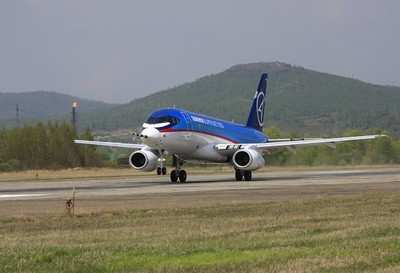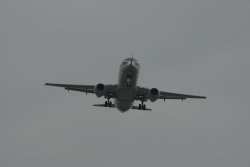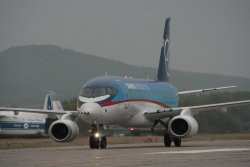Wed, Jun 09, 2010
Sukhoi Superjet 100 Completes Engine Water Protection Test
Russian aviation officials said the Sukhoi Superjet 100 SN95003
has successfully completed the test program aimed at evaluating how
the aircraft will perform on wet runways. The tests confirmed that
APU and engines continue to operate normally while operating on a
wet runway within the full range of pre-takeoff modes, from taxi to
V1. The Russian evaluators say that shows the SSJ 100 is capable of
carrying out safe take-offs and landings on water-covered
runways.

File Photo
The tests were conducted in Zhukovsky-based Sukhoi Civil
Aircraft Company Flight test center. A special 120 foot long pool
was constructed on the runway and filled with water to a depth of
about 1.5 inches. The aircraft accomplished a total of 27 runs at
speed ranging between 10 and 150 knots at different engine
settings. Special attention was paid to low speed modes, take-off
mode and maximum thrust reverser. The tests were monitored by
Russian Certification Authorities. In order to assess the results
the pilots controlled the engines' performance via standard cockpit
indication.

File Photo
Video and still photos were captured using cameras placed at
varying distances from the pool, and mini-cams placed on the
landing gear of the aircraft. It confirmed that the water does not
hit the air intake or the auxiliary power unit. The engines and
aircraft were closely inspected after every run, and no malfunction
of the auxiliary power unit or propulsion system was
registered.
Air data system sensors, air intakes and drain openings in the
airframe sustained normal operation while the aircraft was moving
through the water veil. The stability & control of the aircraft
were evaluated as well. The results of the tests showed that, even
up to 150 knots, the aircraft tracks steadily along the water
covered runway.

File Photo
Russian officials say the tests show that the design
characteristics (location of the engines and, air intakes and drain
openings) of the SSJ100 do not allow water to hit engine air
intakes or the APU through the full range of speeds including runs
with thrust reversers engaged.
More News
Airplane Bounced About 3 Ft Then Touched Back Down And Then, With No Brakes Applied, The Airplane Began Veering To The Left Analysis: The pilot entered the airport traffic pattern >[...]
Aero Linx: British Microlight Aircraft Association (BMAA) The primary focus within all aviation activity is SAFETY. In all aspects of our sport SAFETY must come first, whether it b>[...]
From SnF25 (YouTube Edition): William Wynne Builds Practical Aircraft Engines on the Corvair Platform Seeking an affordable alternative to the traditional aircraft engine options, >[...]
How To Get A Story On Aero-TV News/Feature Programming How do I submit a story idea or lead to Aero-TV? If you would like to submit a story idea or lead, please contact Jim Campbel>[...]
From 2023 (YouTube Edition): Bridge of CiES CiES Inc. is a Bend, Oregon-based designer and manufacturer of modular embedded aircraft systems and sensors. The company’s fuel-l>[...]
 NTSB Final Report: Aviat A1
NTSB Final Report: Aviat A1 ANN's Daily Aero-Linx (07.08.25)
ANN's Daily Aero-Linx (07.08.25) Classic Aero-TV: Fly Corvairs Reliable Engine Alternative
Classic Aero-TV: Fly Corvairs Reliable Engine Alternative ANN FAQ: Contributing To Aero-TV
ANN FAQ: Contributing To Aero-TV Classic Aero-TV: CiES Fuel-Quantity and e-Throttle Systems Praised
Classic Aero-TV: CiES Fuel-Quantity and e-Throttle Systems Praised





